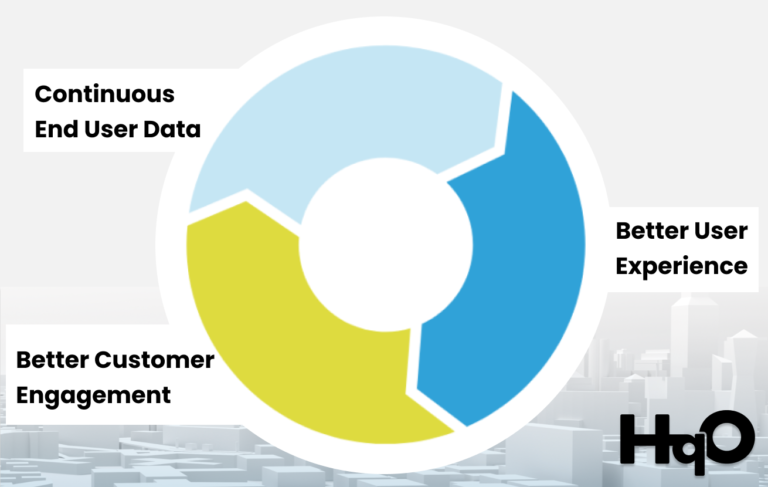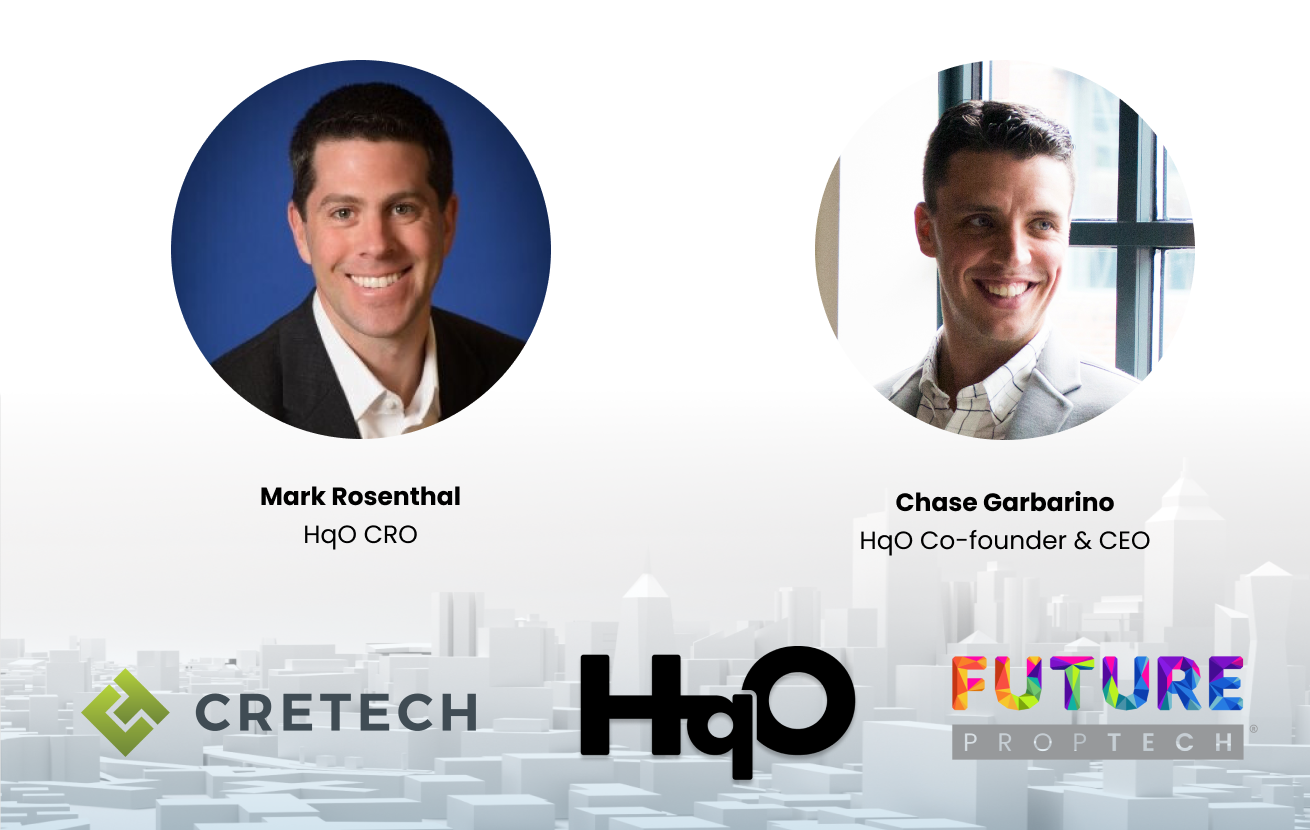What if we told you that the things you can’t always see about your office — such as the hidden data revealing how tenants really use your building — have the most influence on the success of your business, now and in the future? Differentiating with data is just the strategy to gain a leg up on your commercial real estate competition.
Recently, HqO CEO Chase Garbarino and CRO Mark Rosenthal took part in CREtech and FUTURE PropTech’s Reimagining Real Estate Global Summit, the first-ever global virtual event devoted to real estate technology and innovation. In their session, they discussed ways to increase tenant retention and satisfaction by making data-driven decisions about office buildings, and how we can use that data to understand the new set of value drivers for the commercial real estate (CRE) industry. Here are their main takeaways, and how HqO is helping shape CRE moving forward.
Data is Key: How to Succeed in the Market
As we focus on the future development of commercial real estate (CRE) and the application of data and technology, one thing is for certain: if you’re not combining data today about your buildings, your systems, and your users, then you’re already behind in your industry.
There are some great examples of how other major companies have found success by differentiating with data. Let’s take a closer look at some of their stories.
The healthy rivalries among fast food giants, such as McDonald’s and Burger King, can tell us a lot about differentiation and retaining clients. It’s a common occurrence to see similar quick-serve restaurants located directly across from one another, despite the differences between the two being extremely narrow. In fact, one can argue that about 90% of their business is identical: they serve the same market, the same menu, and even the same customers. If this is the case, then why do they choose to be located next to their biggest competitors, and how do they differentiate in their outreach to customers to remain successful?
The simple answer is that location — contrary to the common adage — isn’t everything, and it also doesn’t need to have a negative impact on one’s business. By collecting and using the right data, owners can create unique experiences that distinguish their organizations through the remaining 10%. Even the smallest details — such as “secret sauces” and how efficiently customers move through the drive through — can make a significant impact and generate value.
Though the markets vary, this same concept of differentiation through data has played out with other notable companies: it can be seen everywhere from Spotify’s recent hold on the music industry, to Uber’s takeover of the taxi industry, to Amazon re-shaping the way we conduct e-commerce.
These “disruptive innovators” — a term coined by scholar Clayton Christensen to define innovations that disrupt an existing value network through the creation of new value drivers — have a few things in common. First and foremost, they remain flexible and adaptable as new technologies emerge. They then use this technology to collect data from as many sources as possible to get a more holistic understanding of their consumer base. With a more well-rounded perspective, they can leverage this information to tune in to what their end users really care about.
This rings true for the CRE industry as well, where property owners need to differentiate themselves among a market of similar tenants, locations, and offices. This can’t be done without combining the data about your building, its systems, and its end users. At the end of the day, if you’re not seeking out and gathering the right information about your building, you’re already behind.
Compounding Interest via Virtuous Feedback

Though the return on investment (ROI) for office data collection may not be immediately evident, successful leaders in the industry understand the urgency behind this practice. They also know that the intelligence they collect compounds on itself.
By tapping into how tenants really utilize office buildings throughout the day, digital technologies can bring CRE leaders closer to their end users than ever before and help them address specific needs. This type of engagement forms what we refer to as a virtuous feedback loop. When you have intelligence on the end user of your product from multiple sources, you’re able to create a better user experience, which in turn increases customer engagement and continues to provide you with more — and better — data.
This feedback gives market leaders the competitive edge they need: with direct access to real-time data, owners can remain one step ahead and consistently improve the tenant experience without worrying about disruptions to the market.
Shaping the Future of the Office
Collecting CRE data will also play a role in the future of the office. For far too long, the industry has just assumed that you need an office in order to do work. The COVID-19 pandemic has since caused a major and drastic shift in ideology, leaving property owners to determine the values behind keeping and maintaining physical office space.
In order to successfully address the digital alternatives to the office, property owners need to be more involved in the environments of their tenants. According to the book Atomic Habits by James Clear, even the smallest changes to one’s environment can drastically impact human behavior. For example, modifying a floor plan to incorporate the right signals can prompt end users to improve habits such as eating healthier and collaborating more with peers. Google has successfully used these tactics to improve productivity.
In terms of what this means for office space, a well-designed, data-driven work environment can likewise increase productivity, employee performance, happiness, collaboration, and more — values that often see a decline while working remotely due to distractions and other responsibilities present in the home.
Becoming Data-Oriented with the Digital Grid
To enable owners and landlords to be as granular as they can about the usage of their product, the office sector needs to move in the same directions as Spotify, Amazon, and the other innovative disruptors by adopting the three phases of becoming more data-oriented:
- Determining what data is needed
- Collecting the data
- Analyzing the data to provide insight to employee needs
Owners can’t be expected to do this alone. Instead, they need a partner that can provide a data model to gather intelligence across buildings and help benchmark their assets against others in their respective markets and neighborhoods.
Thus, we created HqOS. HqOS, our end-to-end operating system for commercial office buildings, gives owners the data they need to understand how people actually use their building. It empowers leaders to take advantage of both a tenant-facing application and a unique Marketplace for technologies, amenities, vendors, and services — bringing necessary experiences to life in an easy-to-navigate interface and creating insightful data points that can be combined with information from our Digital Grid.
The Digital Grid further lays the groundwork for how property owners can collect data in a central, organized location. Our smart data model can analyze different human behaviors throughout any asset, from elevator usage to access control systems to individual room occupation. We take this information a step further by comparing this data to other similar and/or nearby buildings. With over 100M square feet of commercial office space and 200 individual assets already using HqOS, the Digital Grid unlocks intelligence and informs decisions that commercial office owners previously had to make with little or no data — or never would have known to make at all.
In order to successfully differentiate your office, you’ll need to improve your building by optimizing the end user experience. Without access to quality data and intelligence on how tenants and employees are using your building, you’re flying blind.
Moving Forward
As we continue to understand the new set of value drivers propelling the CRE industry forward, there’s no better time to start collecting as much data as you can to differentiate yourself through the tenant experience (TeX). Data-driven decision-making has become an imperative for property owners, who can no longer rely on office availability alone to remain successful in the market.
The more you know about how people use your asset, the more you’re going to be able to change the experience of the asset to continue to collect more data. The sooner you begin differentiating with data to create a customer-centric business operation, the sooner your asset value begins to compound.
We’re here to help you enter the “new normal” by achieving your desired work outcomes and optimizing your assets for what tenants really need. With products like HqOS and the Digital Grid, you will have access to CRE data at a scale that has never been seen before in the industry. Before you fall behind, make sure you get ahead.



